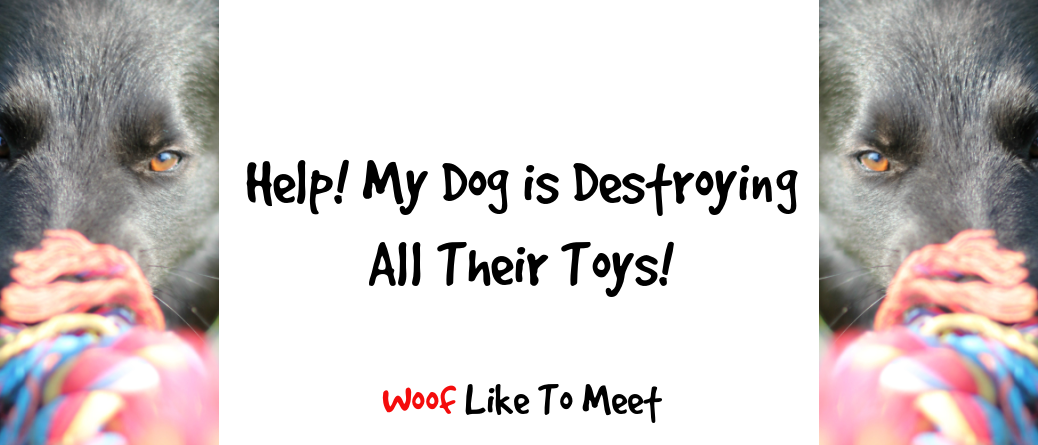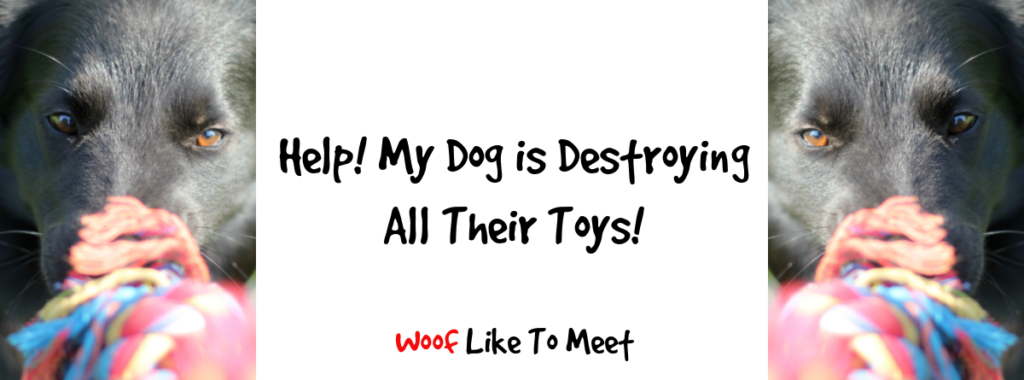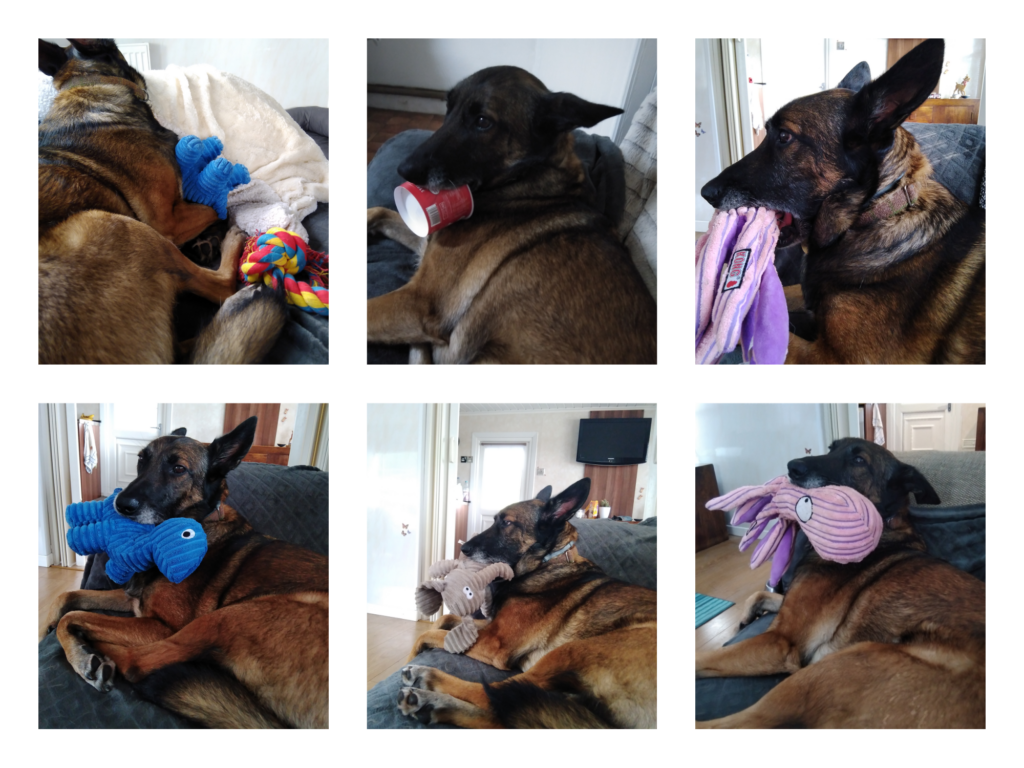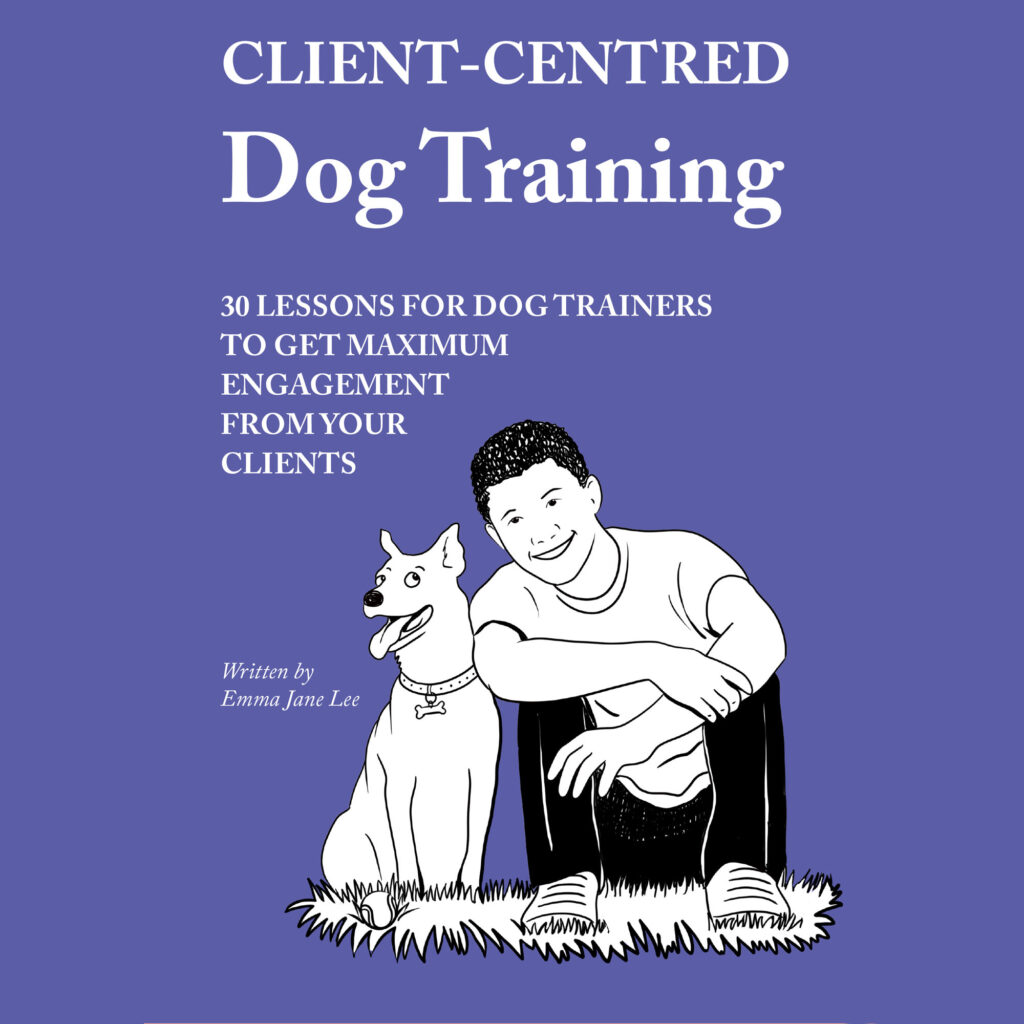As the guardian of two dogs who always relinquish anything I ask them to, I feel pretty blessed. Lidy was so destructive in the shelter that she chewed her wooden kennel and also couldn’t be left with any bedding at all. She did have three or four good toys which she often carried about, but sheets and towels, dog beds and cushions were all things that she’d likely tear to pieces given half the chance.
Yet here, with her collection of stuffed animals, she might give them a good shake from time to time, but she never pulls them to pieces.
If you have a destructive dog, it can be a nightmare. If they’re tearing things to shreds, you can end up having to clear up a real mess. If they’re tearing things to pieces and consuming them, you may end up with a rush to the emergency vet, an x-ray and a day of starvation if not a surgical procedure to open them up and remove whatever it is they’ve ingested.
Destruction can be pretty natural behaviour. You may even be adding it to your dog’s day as a form of enrichment if they really enjoy doing it and it’s not dangerous. Most of us would be pretty happy if we had ‘controlled’ destruction: that our dogs understood what they were free to destroy and they stopped when we asked.
If you’re the guardian of a dog with powerful jaws and a tendency to tear things to pieces, a dog whose destruction is uncontrolled, then it may be driving you to distraction. How do we move a dog whose destruction is uncontrolled to a dog who knows what they can chew and what they can’t, what they’re supposed to do with things and when they need to stop?
The first is to understand that destruction is a perfectly natural part of the dog’s behavioural repertoire. Whether they are eating things or they are playing, chewing things and pulling things apart can feel pretty good to the dog. They may be chewing and destroying things that resemble food items that wolves or other canids would catch in the wild: it’s not a great leap of manufacturing to go from a buffalo to a shoe, after all. Many things that dogs like to destroy can be things that they resemble prey species – or, at least, part of them. I can’t tell you how many spaniels and golden retrievers I’ve known who had a thing for tissues. My nana’s American cocker spaniel would have happily pulled every single tissue out of the box and left them strewn around the bedroom. I’ve worked with a few English cocker spaniels who had a real problem with tissues and would growl or bite their guardians if they tried to remove them. Having never pulled feathers from a bird myself, I can’t really say that it feels the same at a neurological level as killing pheasant and wood pigeons, but I imagine it might, just a little bit.
Other dogs I’ve worked with have had a real thing for fabric, especially floaty fabrics. It’s not uncommon for dogs to really like the rip of fabric. Having never shredded fascia, ligaments, skin or muscle, I can’t tell you if it feels the same to pull a towel apart, but I imagine it might well.
The first thing you need to do is rule out any age-related causes like still being a puppy or a teenager. That’s not to say that it’s inevitable or unpreventable just because the dog is young, but that you’re going to need some more management as their brain isn’t working at full capacity to inhibit impulses yet.
You also need to rule out developmental issues, health issues and self-soothing. Heston hadn’t chewed anything for years, and now he likes to suck holes in soft fabrics. He only does it before he sleeps or if he is coping with being alone. It’s very much his way of comforting himself. Destruction and chewing can be clues as to illnesses and imbalances, particularly anxiety. Lidy destroyed things in the shelter because she couldn’t cope. The only time she destroyed anything here (she ripped some of my clothes that were in a washing basket) was when there was a storm and I was teaching in the next room. She couldn’t get to me because she was behind a baby gate and I couldn’t hear what she was doing because I had headphones in. Destruction can be a sign of psychological distress as much as any other behaviour.
Also, rule out lack of supervision. Is the dog only destroying things when you’re not there? If so, the first thing you’ll need is video so that you can work with a professional to rule out separation-related issues, to rule out boredom, to rule out whether a punishment schedule is in play when the guardian is present and to work out the function of the behaviour. Why don’t Heston and Lidy destroy things when I’m there? Well, I hate to say it and I’ve never actively punished them – or even inadvertently punished them – but my presence inhibits their behaviour. Even if we interrupt or remove a toy, if they’d naturally tear it to pieces in our absence, then our absence means there’s no external pressure to comply. You don’t need to have even yelled at your dog – but if you intervene in any way, you’re an external force rather than the dog really knowing not to chew. I’m fine with that, by the way. I don’t expect my dogs to have the willpower not to destroy things in my absence. They’re dogs, not people. I used to teach classes of 16-year-olds who’d hide classwork if I was absent and they had a supply teacher. That other beings will behave differently in my absence is just a fact of life. It doesn’t mean I’m an ogre. It just means that my interventions to support them in the choices they make are scaffolds, not straitjackets, but scaffolds they need, nevertheless.
So, with those brief provisos in mind, and with this more detailed exploration of why dogs chew and destroy things also considered, I’m going to take the example of a dog who is destroying toys and chews in the presence of their guardians.
What do they need to know?
#1 How to cope with frustration
If you’re going to remove things from a dog, the dog first needs to know how to cope when you do. If they can’t, you’re potentially going to end up with worse behaviours.
They need to know how to cope when they don’t get what they want or they can’t have what they want. Given that frustration can very easily tip over into aggression, you need a dog who can cope with that. Coping with frustration is also about learning to manage your own emotions and self-regulate better.
If you’re looking for ideas about where to start, this post should help.
#2 How to have control over impulses
If your dog can’t control their own behaviour and they can’t stop what they start, if they can’t self interrupt, you’re going to end up having to wrestle toys or chews from the dog, or try and distract them so you can steal their stuff. Unsurprisingly, dogs are wary of us doing this after the first time we do it, so it’s fine for a one-off emergency, but heaven help you if you need to do it again.
Dogs need to be able to self-interrupt as well as knowing how to stop when asked. Dogs who have no idea how to press their own off buttons are a liability. One of the drivers behind destruction, alongside frustration, is the inability to self-regulate. When Lidy holds her toys ever so gently or she stops pulling the ear off her elephant when I ask (like my mother, she’s a sod for being unable to leave a thread hanging) those skills are impulse control skills. I confess to having a very icky habit around scabs and peeling skin – other people’s scabs and peeling skin – I almost can’t stop myself from wanting to pull them off. I know, it’s disgusting. Even so, if I feel itchy about not being able to pull at some random stranger’s flappy scab or peeling skin, I shouldn’t expect my dog to cope any better than I do. The only thing that stops me is a very long history of rules about socially acceptable behaviour. In other words, I stop myself.
If we want dogs to stop themselves, then we need to teach them how.
#3 Teach them to relinquish items when you ask
Teach them how to drop. Your dog needs to learn to relinquish things. To be fair, most of the dogs I’ve known other than my toy-guardy dogs Tilly, Tobby and Amigo, have all been happy relinquishers of their stuff. If your dog has any kind of history of running off with stuff or reluctance about forced removal, you need Chirag Patel’s Drop. To the letter, no skimping.
Until you’ve mastered this (6-12 weeks of daily practice, I’d say), I’d manage the chewables very carefully. This technique is so good that Lidy spat out a found pigeon wing the other day. She didn’t want to eat it, so there’s that, but it can be such an instinctive reaction that the dog has relinquished before they’ve had time to think that they didn’t want to.
Don’t bother with trading if your dog is destructive. You’re never going to be trading. You’re not giving them something else to destroy. You need a safe way to get them to drop and leave items that also brings them back to you. Chirag isn’t teaching relinquishment, really. He’s teaching the dog that when you say a word, then it’ll be advantageous to come back to you from wherever they are and have an empty mouth, kind of like when my mum said, ‘Tea’s ready!’
Play stopped because tea was valuable and also because of ingrained habit. This method of drop is exactly the same.
#4 Teach the Counting Game
This is another Chirag Patel classic. You may wonder at its use with chewing and destruction. It works perfectly in kind of similar lines to Drop…. ‘Hey! I’m doing something really fun here. Come see!’
You can move the dog away from items, slow them down (spread out your timing and slow down) and speed them up. I use it often when I have novice dogs who have no skills with drop. The Counting Game can be a really good way if I’m doing freework sessions or other stuff to get a dog to come nearer to me.
The added bonus is that the moment you start counting and you bend down in future sessions, the more likely it will be that dogs will stop what they’re doing and come to join you.
#5 Add a wider range of non-destructive enrichment
Like dogs who chase compulsively, destruction can be compulsive too. It scratches a biological itch that other things don’t. Destruction and chewing are part of the predatory motor sequence: the ways that predatory species seek and acquire food. Of course, your dog is not destroying things to consume them, usually. Even chewing of bones can offer very little nutritional value once the marrow has gone. Kill-bites, shaking, tearing things apart and even eating them are much, much later in the sequence. Just like you would with a dog who is compulsively chasing, your job is to do things earlier in the sequence. Scentwork can be really useful. Doing activities like mantrailing or scentwork can help build a behaviourally more balanced dog who doesn’t only have one way to get their kicks. I’m a huge fan of scatter feeding with dogs who destroy. I confess I prefer grass for this – it’s less problematic if they tear up some grass and you can scatter it further away. Snuffle mats are great, but I’ve seen dogs dismantle them in minutes. They just don’t afford you the ability to manage arousal in the same way. I have never, ever known dogs escalate from scatter feeding to vaccuuming the floor, by the way. If your dog does this, that’s something else entirely. Sometimes, it’s just a free buffet and what dog would turn that down? But dogs don’t graduate from scatter feeding to eating anything on the ground. Scatter feeding lasts much longer – I’ve never known a snuffle mat last more than 10 minutes with a single ration of food – and I’ve two enormous snuffle mats. I’ve had dogs still scouting for one single handful of chopped ham over 45 minutes later. Tilly once was out there for two hours still endlessly searching for the last bit of ham.
#6 Recognise destructive behaviour as part of adolescence and deal with it accordingly
Most destructive behaviours start young and fade, but some dogs get more excited by the destruction than others, particularly during their teenage years when it can provide an outlet.
Make sure you’re clear about the suite of behaviours that destruction might fit in to. If you recognise a number from this post, then you might want to think about ways you can channel your dog more appropriately through focus games, through the activities listed above and through careful management. Dogs who don’t learn what a thrill destruction can be from 8 weeks to 2 years of age are generally dogs who don’t destroy things the rest of their life either. For instance, rural France is not a toy-based dog culture as a whole and so a lot of our dogs have no idea what toys are. That doesn’t mean they’re not destructive: some are destructive despite the presence of toys. Many, though, if they are destructive do so because their behaviour early on wasn’t managed and their needs weren’t met. Meet a dog’s needs and you don’t tend to find them destroying the kitchen cabinets.
#7 Interact more with your dog
Destroying things is not just a predatory motor sequence thing, it’s also a form of entertainment and a way to engage with the environment. When we play more with our dogs and we interact with them, then we can meet their needs in other ways. To be honest, a dog who only enjoys life when they’re pulling the stuffing from cushions seems to be a pretty miserable dog if you ask me. Massage, petting sessions and training sessions can be ways of building up your own bond, as can interactive play.
Before everyone clutches their pearls, I’m not talking about turning your dog into a ball addict or doing irreparable damage to them physically and mentally. A balanced diet of a bit of tug, a bit of chasing, a bit of scentwork, a bit of massage, a bit of frisbee, even – dare I say it – physical play with your dog can be different ways for you to meet your dog’s needs to play. As one of our lovely DoGenius students wrote in their essay at the weekend, pseudopredation (so, finding, stalking, herding, pouncing, biting, shaking, grabbing, dissecting) could well be as much about play as it is about predation. Play more, and choose more interactive or social ways of doing so. A broad range of play skills is also a muscle you can build, just as you can build up scent work and so on. If dogs are making their own fun – essentially what destruction is – then get involved with them.
#8 Build bite inhibition
Some people seem to think that bite inhibition and bite strength are things dogs are born with. They’re not. They’re taught skills that they learn through life. Being born a dog teaches them to bite. Being socialised teaches them WHEN and HOW to bite. Destruction is sometimes about learning to hold back.
The mouth is bones and teeth secured by and operated by muscles. Bite inhibition is just choosing the right bite strength (or none at all) for the moment. Given that the mouth is controlled by muscles, it is an eminently trainable thing. It’s no different than our hands. Remember how you used to paint when you were four? Half the battle was holding the brush. We learn skills with our muscles that stop us over or under-reacting to the process we’re about to undertake. We don’t still paint and write like four-year-old children. Burly, muscley men can still learn to knit delicately if they try, just as dogs can learn to bite less hard.
How do I suggest you do this? Play! A great tug programme like Craig Ogilvie’s INTERACTIVE programme is ideal. Like any other muscular skill, it can be shaped over time. Of course, it’s easiest when you’re working with a fairly young dog, but it’s something all dogs can learn.
It’s not a question of finding more robust toys that can outlast your dog’s jaws. If your dog is that much of a chewer or a destroyer, the likelihood of hairline fractures and other dental damage is huge. Ideally, all dogs should be able to choose a grip that suits the thing they’re gripping. Many people are too afraid to intervene or don’t know how without causing frustration and potential aggression. It’s really important that we help our dogs get their needs met, but that their needs don’t end up bordering on a compulsion.
PS: I’ve got a book out, as if you didn’t already know! If you’ve read it already, please leave me some feedback! Pop over to Amazon now and wax lyrical.




